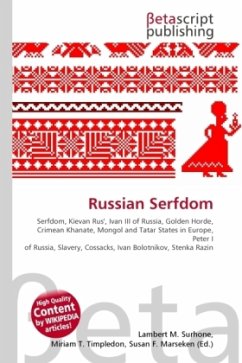High Quality Content by WIKIPEDIA articles! The origins of serfdom in Russia are traced to Kievan Rus in the 11th century. Legal documents of the epoch, such as Russkaya Pravda, distinguished several degrees of feudal dependency of peasants. , the term for an unfree peasant in the Russian Empire, krepostnoi krestyanin ( ), is translated as serf. The legal code of Ivan III of Russia, Sudebnik (1497), strengthened the dependency of peasants, statewise, and restricted their mobility. The Russians persistently battled against the successor states of the Golden Horde, chiefly the Khanate of Crimea. Annually the Russian population of the borderland suffered from Tatar invasions and tens of thousands of noblemen protected the southern borderland a heavy burden for the state which slowed its social and economic development and expanded the taxation of peasantry.
Bitte wählen Sie Ihr Anliegen aus.
Rechnungen
Retourenschein anfordern
Bestellstatus
Storno








